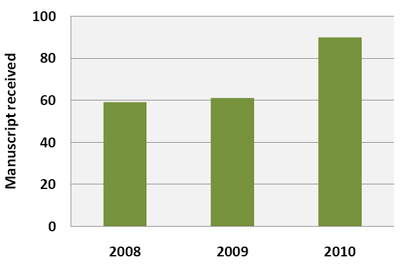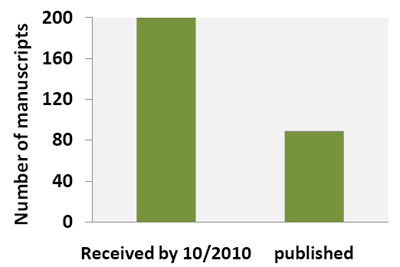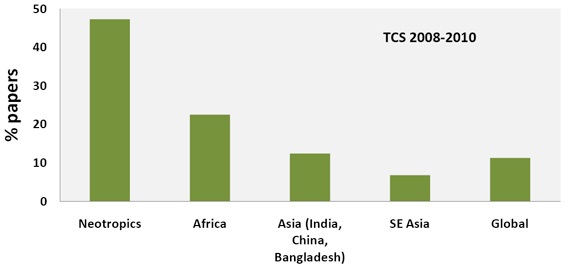
|
|
|
Continued growth of Tropical Conservation Science: three years of existence [ i-v ]Alejandro Estrada and Rhett ButlerAbstract The current issue of TCS marks the third year of existence of Tropical Conservation Science. During 2010, TCS published 32 papers plus four editorials, totaling 472 pages, across four issues. Notably, in 75% of the papers published in 2010, the main author was native to the tropics, 97% were written in English and 1 in French. Through the first 11 months of 2010, TCS papers were downloaded more than 58,000 times, a 29% increase over the same period last year. The TCS site had about 26,000 visitors, a rise of roughly 30% over 2009. As of November 2010, the executive editor of TCS had received 90 manuscript submissions, accounting for a total of 210 manuscripts received in the editorial office since the launching of the journal in March 2008. Manuscript submission increased significantly in 2010 (see graph below).  All manuscripts received by the executive editor go through an initial process of evaluation to assess their suitability, a task accomplished with the assistance of members of the editorial board. Manuscripts that are considered suitable are submitted to the peer-review process and scored into three categories: accept with minor revision, accept with major revision, and reject. In 2010, 124 referees (see Appendix 1) kindly assisted TCS in the peer review, and we are grateful for their participation in this process. The above process results in an important filter that sustains the high quality of manuscripts published in TCS. In this context, the graph below shows that only about 45% of total submitted manuscripts between 2008 and Oct 2010 were accepted for publication.  Geographic coverage by papers published in TCS An overview of the geographic regions covered by published papers in TCS between 2008 and 2010 shows that almost 50% of the papers reported on conservation issues in the Neotropics. Importantly, studies in Sub-Saharan Africa accounted for 22% and those in Asia and SE Asia for another 17%. Studies reviewing or assessing conservation issues on a global basis contributed to 11% of the papers.  Indexing of TCS One important achievement of TCS in 2010, and a consequence of the velocity with which it is penetrating the field of conservation science in the tropics, is its inclusion in several indexing systems. In late 2010 we were notified by SCOPUS, the largest abstract and citation database of research literature and quality web sources covering nearly 18,000 titles from more than 5,000 publishers, that after an evaluation of TCS performance it had decided to include the journal in its indexing system. Copyediting of manuscripts published in TCS We are particularly grateful to Mr. William Bridges, Director (Ret.), Pulliam School of Journalism at Franklin College, for copyediting each of the manuscripts written in English and accepted for publication in TCS in 2010. Popular summaries of papers published in TCS As was the case for earlier issues, complementary to the publication of their papers, the authors of papers in the fourth issue of TCS, also kindly prepared popular summaries of their work. These summaries were translated into Spanish, Portuguese, and French, if the paper was published in English. Summaries of each paper in each of these four languages were published on the TCS website and used also for press releases and for dissemination through various channels to the global scientific community and to the public at large. Translation of these summaries into Portuguese, French, and Spanish was accomplished with the assistance of colleagues and graduate students from Brazil, Mexico, and France, who kindly donated their time and effort to this task. The fourth issue of TCS-2010 The current issue of Tropical Conservation Science (TCS) contains eight papers. These cover such topics as: assessing if protected areas are useful in protecting populations of an Atlantic rainforest palm in Brazil; profiling bird abundances in primary and secondary forests in Papua New Guinea; determining which features of the landscape drive complex spatial microclimate configuration of Brazilian Atlantic forest fragments; the use of hair-snares as a non-invasive method for monitoring felid populations in rainforests of southern Mexico; patterns of water body use by Asian elephants and their conservation in southern Sri Lanka; effects of climate change and conservation of subtropical forests of South America; translating boardroom philosophy into conservation action on the ground in the context of oil palm production in southeast Asia; and the use of social norms or codes of conduct that govern relations within and between communities as a natural resource governance tool in southwest Madagascar. The eight papers of the current issue highlight an important diversity of conservation issues of concern to conservation scientists and local societies, including also issues of global and regional concern—conservation without borders. Appendix 1. List of referees who reviewed manuscripts for TCS during 2010.
The opinions expressed in reader comments are those of the author only, and do not necessarily reflect the opinions of other authors or Tropical Conservation Science. |
 |
Tropical Conservation Science is an open-access e-journal that publishes research relating to conservation of tropical forests and other tropical ecosystems.
Volume 3: Issue 4 Table of Contents Articles All issues Mar 2008 Jun 2008 Sep 2008 Dec 2008 Mar 2009 Jun 2009 Sep 2009 Dec 2009 Mar 2010 Jun 2010 Sep 2010 Dec 2010 Mar 2011 Jun 2011 Sep 2011 Dec 2011 Mar 2012 Jun 2012 Sep 2012 Dec 2012 Mar 2013 Jun 2013 Aug 2013 Sep 2013 Nov 2013 Dec 2013 Mar 2014 Jun 2014 Sep 2014 Dec 2014 Mar 2015 Jun 2015 Sep 2015 Dec 2015 Mar 2016 Jun 2016 Most downloaded 2008 2009 2010 2011 2012 All time ADVERTISEMENT SEARCH  This work is licensed under a Creative Commons Attribution-NonCommercial-NoDerivatives 4.0 International License. |
|
About | Privacy Copyright mongabay.com 2008-2014 |